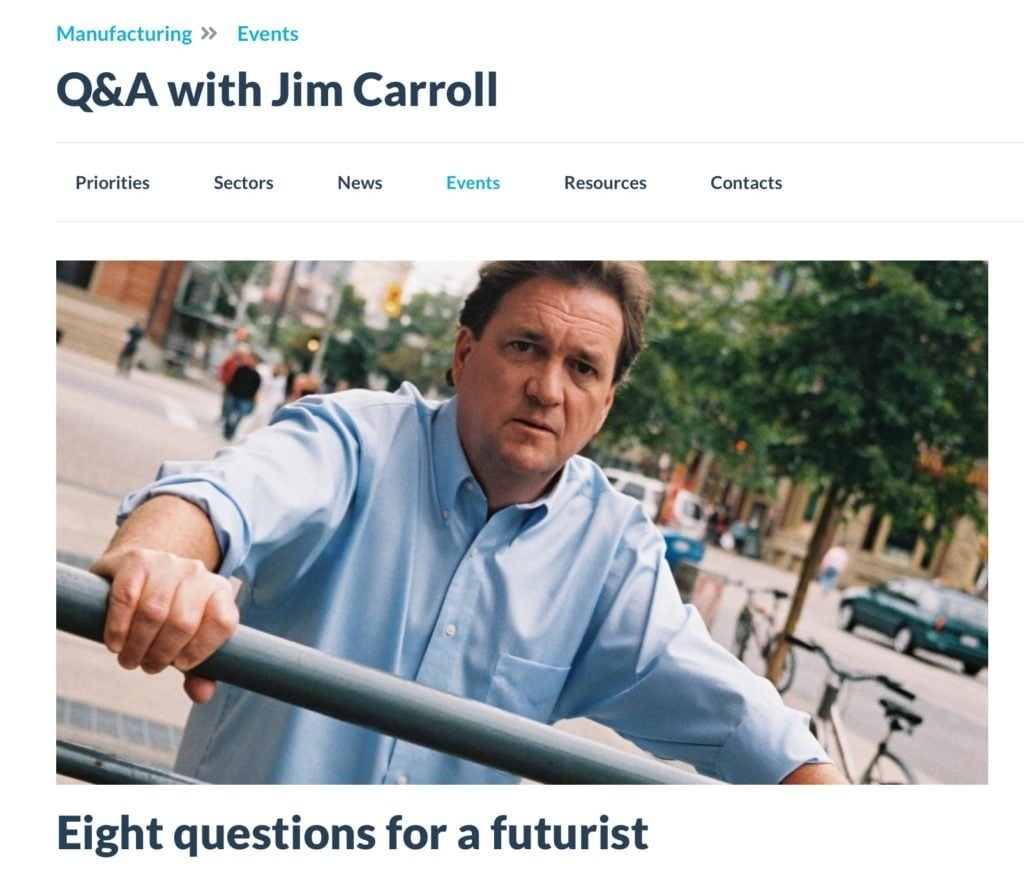The International Finance Corporation, a member of the World Bank Group, is having me in to Marrakesh to headline their 2nd global conference on manufacturing in just over a month. Learn more about the event here.
They recently interviewed me on some of the manufacturing trends and opportunities that I see in the world today.
Eight questions for a futurist
Insights from Jim Carroll, the renowned futurist and keynote speaker at the upcoming IFC Global Manufacturing Conference
1. What is your mantra for the future?
“Think big, start small, scale fast.”
2. What is the most frustrating issue for manufacturers today?
The big overwhelming issue is the speed of change. The future belongs to those who are fast. The speed in which trends come about is simply staggering and difficult to keep abreast of. Five years ago, 3D printing was seen as some farfetched crazy idea. Now it’s mainstream. Everyone is talking about “how do we get there, how do we do that, how do we keep up.”
3. In five years, will the manufacturing process look different?
The very nature of product development, design and manufacturing is changing. It used to be that you had to commit a lot of money to come up with a design, you had to commit to manufacturing in massive quantities and you hoped for the best. That has changed. Now we’ve got the concept of rapid prototyping and rapid development. Add to that 3D printing and it’s become an iterative design and manufacturing process, so you can conceive of an idea, print it, try it out and see if it works. And if doesn’t, you can immediately redesign it and do another kick of the can. That is a very substantial change because now we have less at risk.
4. Does that mean that smaller manufacturers will play a larger role?
You don’t have to be some mammoth global powerhouse do things now. You just need the of equipment, the cost of materials, the cost of prototyping, the cost of 3D printing. We’re seeing a lot of potential with crowdfunding. I could be somebody small anywhere in the world and conceive of an idea, raise funds for it and quickly prototype and play with it to get some momentum. We are going to see people do things they haven’t done before.
5. So, can we expect new innovative centers to emerge?
History has taught us that out of necessity, a lot of innovative ideas come from emerging economies, and that it often takes time for the developing world to catch up. Kenya was doing mobile payments via cell phone years before it hit the industrialized world and that was because of the lack of landlines there. As a result, we had this massive, sophisticated online payment system emerge that leapfrogged the rest of the world. Now we are seeing a lot of innovation around water usage and battery usage. The impetus is “we need to solve a very significant local problem.”
6. Where do you expect innovation to thrive?
As we get massive global urbanization – there will be 30 mega cities by 2035, with over 30 million population each – a lot of complex problems will arise that will be addressed with a lot of unique local solutions. There is growing consensus that over the next 25 years the emerging economies in regions of Africa will become important, particularly as we start to solve water issues.
7. Will those innovations spur more traditional manufacturing jobs in emerging economies?
We have to get out of this mindset that jobs are just traditional manufacturing jobs. The future of manufacturing for emerging economies isn’t just doing things locally. Why not have a workforce that can remotely manage manufacturing processes and machinery 5,000 miles away.
8. Is it reasonable to believe that the commitment to sustainability is here to stay?
There is fairly large-scale global support for sustainability and I only see it expanding. Today, companies and brands are under a very new and different microscope. In the era of social media, companies are only one disaster away from a massive Tweetstorm which can do your brand lasting damage, so for that reason, and others I think the commitment is here to stay. And I think from a reasonable perspective, countries understand that if they want to step up to the global stage they have to be seen as good global citizens.





GET IN TOUCH
Jim's Facebook page
You'll find Jim's latest videos on Youtube
Mastodon. What's on Jim's mind? Check his feed!
LinkedIn - reach out to Jim for a professional connection!
Flickr! Get inspired! A massive archive of all of Jim's daily inspirational quotes!
Instagram - the home for Jim's motivational mind!